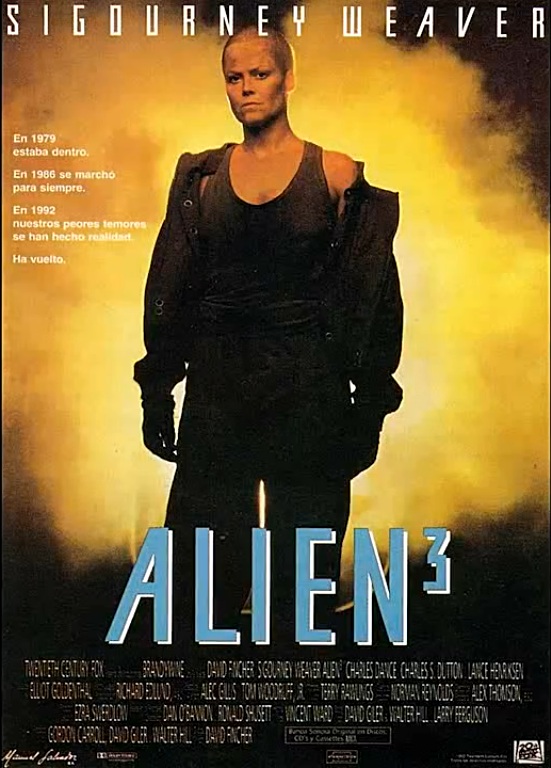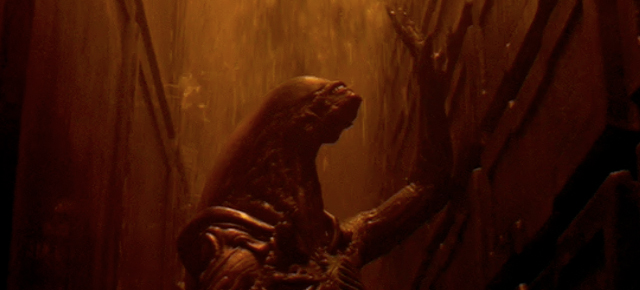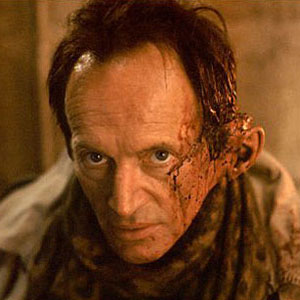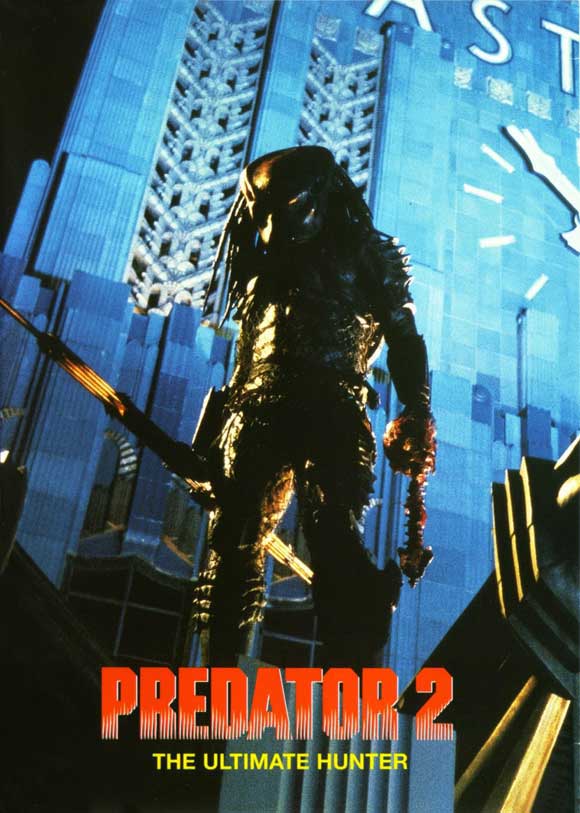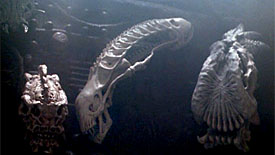SPOILER WARNING:
Alien vs. Predator (2004):
Let’s take some aliens that see only in infrared, and have them hunt another bunch of aliens that (as we were informed in Aliens) “don’t show up on infrared at all.” Yay that.

But is the title Alien vs. Predator, or AVP: Alien vs. Predator, or just AVP? Who cares, let’s call it AVP for short.
This is one of the ones I saw for the first time only recently. And although I hadn’t seen Prometheus when I watched this, I knew enough about Prometheus to be startled at the similarities between the two movies. Ridley Scott’s dismissal of AVP (he even claims never to have seen it, though he must surely be aware of the basic plotline) is ironic, since Prometheus seems to owe AVP a considerable debt. But more about that in Part 5.
AVP in turn owes a debt – acknowledged by the filmmakers – to H. P. Lovecraft’s At the Mountains of Madness; both feature two races of aliens – one high-tech and somewhat human-relatable, the other a bunch of creepy monstrosities – fighting it out in an ancient underground structure in Antarctica. Lovecraft’s novel was in turn inspired by, and to some extent a sequel to, Edgar Allan Poe’s Narrative of Arthur Gordon Pym, which has arguably also left its mark on AVP, as it features an underground structure on an Antarctic island whose mammoth inscriptions are a mixture of Egyptian, Ethiopian, and Arabic script. (Trivia fun: Jules Verne also wrote a sequel to Poe’s book.)
In AVP the three languages are Egyptian, Cambodian, and Aztec, and the theory is that the underground pyramid was built, under Predator supervision, by an ancient culture that was the predecessor of those three cultures. Hence its language was a blend of all three languages, which explains why the archeologists can decipher it.

I think I saw this place in Las Vegas
This is, if one is inclined to cavil, not enormously plausible. Archeologists and historians date the origins of recognisably Egyptian culture to several thousand years earlier than the other two; so the suggestion that they are all continuations of some earlier culture is a bit of a stretch. And the notion that a precursor language to Egyptian, Cambodian, and Aztec would be a mixture of readily recognisable symbols from each language betrays a curious view of linguistic evolution; it’s as though the common ancestor of apes and humans had one apish arm and one humanish arm. (Of course the temptation to link Egyptian with Aztec pyramids, and trace them to some sort of Atlantean and/or extraterrestial beginnings, is not exactly unprecedented in sf – the original Battlestar Galactica being a case in point. And in the interests of full disclosure, I wrote a comic book along similar lines as a teenager.)
But that’s hardly the only scientific howler in the film. My favourite is the archeologist who predicts that the pyramid – a labyrinth of constantly-shifting chambers, hallways, and death traps (basically Indiana Jones meets Cube) – will automatically reconfigure every ten minutes, because the Aztecs used base 10. No need to prove that the Aztecs used minutes, apparently. (And minutes aren’t an especially decimal unit ayway.)
There are continuity problems as well. Both of the previous Predator movies made a point of establishing that the Predators are partial to high-temperature climates, staying away from even normally warm regions except during extreme heat waves. So it’s a bit puzzling to see them strolling unperturbed around Antarctica. But then the same could be said of the humans – especially of the final scene with Woods standing in the bitter polar wind, hatless and jacketless, without a shiver.
Moreover, we’re told that the Predators have to lure humans into the pyramid as hosts for the xenomorphs: “Without humans, there could be no hunt.” Yet if, as we learned in A3, xenomorphs can gestate in nonhuman animals, why are humans needed? (Perhaps xenomorphs are smarter, and so more challenging prey, if they gestate in smarter organisms? I suppose that’s possible, though the one in A3 wasn’t exactly a pushover.)
Moving from plot holes to mere weaknesses: throughout the entire Alien series, the great fear has been the danger that the xenomorphs will make it to Earth, where they’ll be unstoppable. This concern is somewhat undermined by the revelation that Predators have been bringing xenomorphs to Earth for thousands of years. Admittedly, both AVP films portray the Predators as being careful to wipe out all traces of xenomorphs if they get loose – by detonating enormous explosions in AVP, and somewhat less reassuringly in AVP: Requiem by sending one guy with a bottle of blue acid to wander around in the sewers.

Woods and Stafford, dressed for cold weather but not for swarms of homicidal aliens
Still and all, AVP isn’t a terrible movie by any means. It’s visually striking, and clearly a labour of love filled with easy-to-miss fannish references. Sanaa Lathan’s Woods is evidently supposed to be a new Ripley – the savvy, competent woman whose authority keeps getting overridden by overconfident and/or panicked idiots doomed for death – though neither the script nor the actor is quite up to the considerable challenge of rivaling Ripley.
(You may recognise Colin Salmon, the actor who plays Stafford, Weyland’s right-hand man, as M’s right-hand man in the Brosnan Bond movies, and as Dr. Moon in Doctor Who.)
Charles Bishop Weyland himself, dying CEO of the company that will become Weyland-Yutani, and prototype for the Bishop series of androids in Aliens and A3, is a fairly effective character – more sympathetic and nuanced than previous company reps, and certainly more so than the cartoonish villains in Resurrection. The casting of Lance Henriksen provides a welcome a sense of continuity and familiarity: and in a nice nod to Aliens, his Weyland briefly, idly replicates Bishop’s “knife trick”:
The tag line for the film is, famously, “Whoever wins, we lose” (reportedly this is even what the Weyland satellite’s morse code signal is saying at the start of the film); but this is quickly subverted by the film’s actual plot, as should be no surprise given a few seconds’ thought.

Here comes Mama and she ain’t happy
The xenomorphs pose an existential threat to the entire human race; the Predators hunt singly or in small groups, and anyway have no interest in hunting their prey to extinction. The Predators have a sense of honour, or sportingness, or whatever you want to call it, which, while deeply screwed-up, puts some constraint on their destructiveness; it’s likewise possible in principle to avoid becoming their prey either by earning their respect (as Harrigan does at the end of Predator 2, or as Woods does here) or by falling beneath it (e.g., by being sickly or weaponless). By contrast, there is nothing one can do to be off a xenomorph’s kill list (except having a queen inside you, but that’s a suboptimal solution). Clearly the two groups are not comparable evils, and if one has to takes sides, it’s pretty obvious which side to take (as the protagonists quickly figure out).
The special edition dvd adds some good character moments and a brief glimpse of the earlier conflict that wiped out the whaling station in 1904. One striking revelation in the restored scenes is that the Predators in the film are teenagers and this is their ritual entrance to adulthood. I’ve gotta say, if fighting an army of xenomorphs in a deathtrap pyramid is their idea of an adulthood ritual, what the hell is picking off a few humans in a jungle – a cub scout entrance exam?
Aliens vs. Predator: Requiem (2007):
Because the film’s title is so often abbreviated AVP: Requiem or AVP:R, there’s some confusion as to whether the first word is “Alien” singular or “Aliens” plural. Even the insert sheet in the dvd case gets it wrong, giving it as the singular; but the title that actually appears onscreen promises us, accurately enough, Aliens plural versus Predator singular, so I’m going with that. 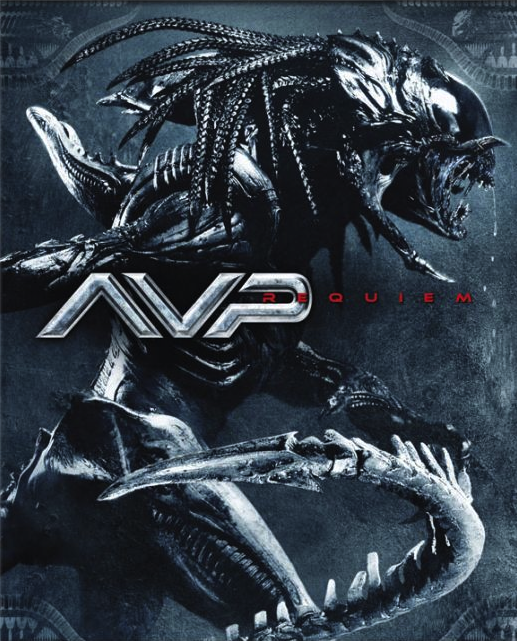 (Though whether “AVP:R” is also part of the title or merely the abbreviation is a topic on which I would not dare to speculate.) The “Requiem” of the title is also accurate, as the wretchedness of this film virtually ensured that there would be no more AVP films.
(Though whether “AVP:R” is also part of the title or merely the abbreviation is a topic on which I would not dare to speculate.) The “Requiem” of the title is also accurate, as the wretchedness of this film virtually ensured that there would be no more AVP films.
For this is indeed the worst of the ten films in this family of franchises. The two AVP movies are often lumped together as similar rubbish, but I find that unaccountable; the second one is a thousand times worse. (Exactly a thousand; I measured it with my agathometer.)
For one thing, it’s the least original of the lot; monsters-invade-a-small-town plots are a dime a dozen, and nothing new is done with that idea here. For another, it’s the most callous, mean-spirited, and pointlessly violent of the films, the one that veers closest to torture porn – with the scenes in the maternity ward being especially revolting and misogynistic. (What ultimately saves it from being torture porn is that the film’s attention span is too scattered to linger on any one scenario for more than a few moments.) For another, watching a lone Predator successfully taking down dozens of xenomorphs necessarily lowers the perceived threat posed by the latter, thus weakening audience investment.
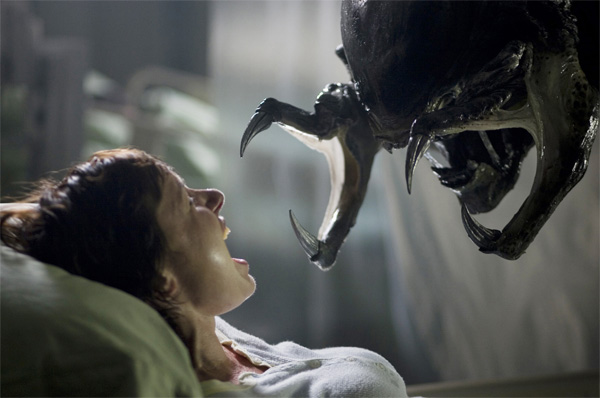
Suboptimal bedside manner in the maternity ward
For yet another, many of the scenes are (famously) so dark that it’s difficult to see what’s happening; though that’s no great loss, as what we can see is, as previously noted, mostly repulsive and meaningless. Maybe the thought was that being unable to see would make it scarier, like being lost in the dark; but instead it just makes your attention shift away from the now invisible world of the film to the now more visible – and unless you’re unlucky, less frightening – world of your factual surroundings. Consequently the film oscillates between ill-lit boredom and better-lit revulsion, but with few actual scares.
At one point a character’s suddenly being attacked is clearly meant to be a surprise; yet when you see him just standing there in the doorway, it’s as though he had the words “cue xenomorph” tattooed on his forehead. There are similar scenes in the other films, but none as unsuccessful as this.
I’m told that the only things that can make AVP:R look good are the Asylum ripoff AVH: Alien vs. Hunter and the Sushi Typhoon (I am not making up the studio’s name) ripoff AVN: Alien vs. Ninja. I haven’t tested this claim empirically, but I suspect it is true; I gather that the latter movie makes the xenomorph a master of kung fu, because, um.
In fairness, AVP:R has a couple of semi-decent moments, as in these mildly amusing exchanges (paraphrased from memory):
– The colonel is lying to us,
– That’s crazy, the government doesn’t lie to people!– Whatever happens, we need to protect Kelly.
– What is this, the Titanic? Women and children first? Screw that shit, it’s every man for himself!
– She’s the only one who knows how to fly the helicopter. Unless you can. Otherwise shut the fuck up.

I just agreed to star in what?
The only slightly interesting character is Dallas, who shares his name with the captain of the Nostromo (and shares a line in common with Dutch in Predator). Yet he and Kelly actually represent a mixed-and-matched version of Ripley and Hicks (he’s a civilian, like Ripley [Ripley’s rank as lieutenant and/or warrant officer is clearly of the merchant-marine rather than the military variety]; she’s a soldier, like Hicks, but protecting a daughter, like Ripley; like both Hicks and Ripley, they’re the only voices of competence and good sense among overconfident and/or panicked idiots). Dallas is also an ex-con, which might be interesting if we ever learned more about what crime he committed and why, or why the sheriff nevertheless seems to trust him. (His joke about looking for work at the bank might mean he’d committed bank robbery, but might instead just be a reference to the difficulty of a convicted felon’s getting a job at a bank.)
My dvd carries only the special edition, but does feature restored footage markers, thus enabling viewers to compare the theatrical and extended versions anyway. The only advantage of the special edition is a couple more brief scenes with Dallas; otherwise, as the back of the dvd case promises, the extra scenes just add “more blood … more guts … more gore!”
Okay, so with AVP:R we’ve hit rock bottom. From here on there’s nowhere to go but up.
Next: Predators and Prometheus.
